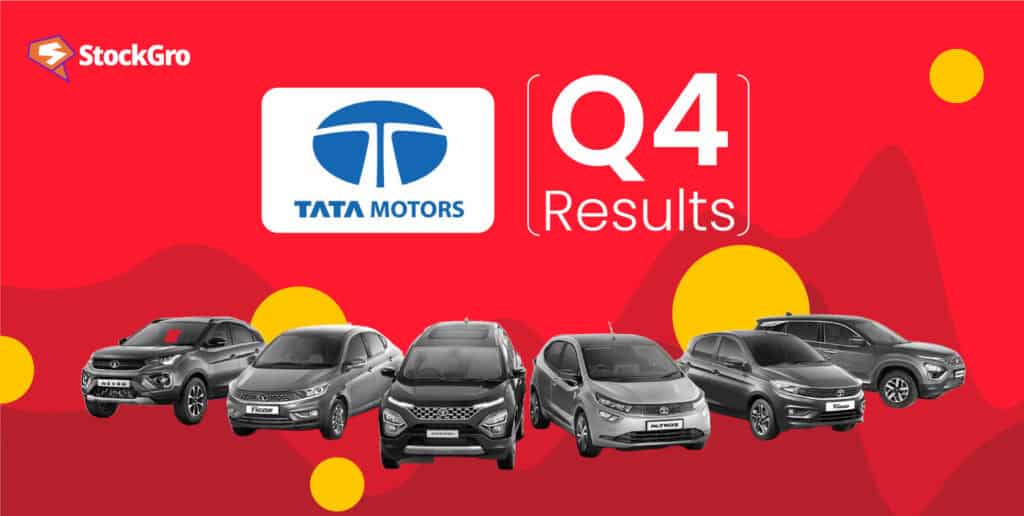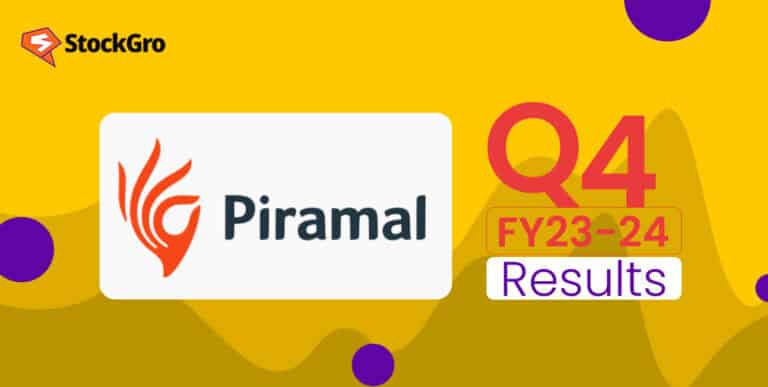
Investors constantly keep a close eye on the automobile sector because the financial performance of significant players in the industry may indicate larger economic trends.
For investors tracking India’s automotive sector, the recently released Tata Motors’ Q4 FY24 results are a much-awaited one. Apart from its financial performance, the Q4 results also shed light on Tata Motors’ business across different segments.
Is Tata Motors a good buy after Q4 FY24 results? Let’s find out, as we analyse these numbers with the stock’s investment potential.
About Tata Motors
As an industry frontrunner, Tata Motors is a car manufacturer with a presence in various countries. As an integral entity within the esteemed Tata group, it presents an extensive array of vehicles, including passenger cars, SUVs, commercial trucks, buses, and specialised defence vehicles, catering to a global clientele.
Thanks to its extensive worldwide network of subsidiaries, associate businesses, and joint ventures (JVs), it operates in several countries, including India, the United Kingdom, South Africa, China, South Korea, Brazil, Austria, and Slovakia. Jaguar Land Rover of the United Kingdom and Tata Daewoo of South Korea are two examples of its subsidiaries.
Also read: Tata Motors announces demerger: Share price surge to cross ₹1000 for first time
Tata Motors Q4 results: Previous quarterly performance comparison
FY24 financial highlights:
- Record revenues: ₹437.9K crore
- All-time high EBITDA: ₹62.8K crore
- Net profit: ₹31.8K crore (a ₹29.1K crore increase)
Q4 FY24 performance:
- Revenue: ₹120.0K crore (up 13.3%)
- EBITDA: ₹17.9K crore (up 26.6%)
- EBIT: ₹11.0K crore (a ₹3.8K crore increase)
- Net profit: ₹17.5K crore (a ₹12.0K crore increase)
Tata Motors has concluded the fourth quarter of FY24 with remarkable achievements across its various divisions. Jaguar Land Rover (JLR) has had an exceptional quarter, recording the highest revenue for both Q4 and the full fiscal year since FY15. The EBIT margin stood at a solid 9.2% for Q4 and 8.5% for the entire year.
The auto industry is moving toward more environmentally friendly products, and JLR is investing in its electric vehicle manufacturing to position itself as a market leader.
Tata Passenger Vehicles division increased its market share to 13.9% in FY24 and maintained its dominance in the EV segment with a 73.1% share. Adding the Tata.ev brand to EVs makes this direction even stronger. The partnership with JLR for premium EVs brings the company’s products to the high-end market.
In the fiscal year 2024, the revenue mix for Tata Motors was dominated by Jaguar Land Rover, which contributed a significant 67% to the total revenue. Tata Commercial Vehicles also held a substantial share, accounting for 19% of the revenue. Tata Passenger Vehicles were responsible for 11% of the revenue, while vehicle financing operations contributed a smaller portion of 2%.
That said, here’s a rundown of all four quarters of FY24.
| CONSOLIDATED RESULTS | JUN ’23 – Q1 | Sept ‘23- Q2 | Dec ‘23- Q3 | Mar ‘24- Q4 |
| Sales (₹ cr.) | 102,236 | 105,128 | 110,577 | 119,986 |
| Net Profit (₹ Cr.) | 3,301 | 3,832 | 7,145 | 17,529 |
| EPS (₹) | 9.64 | 11.33 | 21.14 | 52.37 |
Also read: How is Tata Power leading the way in the PM rooftop solar scheme?
Financial summary: FY24 growth over FY23
| Consolidated results | FY24 | vs. FY23 |
| Revenue (₹ cr.) | 437,928 | 26.6% |
| EBITDA (%) | 14.3 | 360 bps |
| PAT (₹ cr.) | 31,807 | 29,117 |
| PBT (bei) (₹ cr.) | 28,932 | 27,129 |
Tata Motors share news
As of May 13, 2024, Tata Motors’ share price is ₹960.30. According to Tata Motors’ share price history, the stock has gone up 80.92% in the past one year and 443.12% in the last 5 years.
Even though Tata Motors reported excellent fourth-quarter performance, the company’s shares fell more than 9% in early trading on May 13, 2024.
The automaker’s stock price declined as it got conflicting remarks from brokerages. For example, Emkay Global, a brokerage company, kept Tata Motors’ share price target per share at ₹950.
Current financials
| Metric | Value (as of May 13, 2024) |
| Market cap (₹ Cr.) | 3,51,975 |
| Book value (₹) | 255 |
| Dividend Yield | 0.19 |
| ROCE | 20.1 |
| ROE | 49.4 |
| Stock PE | 10.9 |
Competitor information of Tata Motors
| Companies | P/E | Market cap(₹ crores) | ROE (%) | Net profit for the latest quarter(₹ crores) |
| Ashok Leyland | 24.69 | 58227.37 | 15.05 | 608.85 |
| Olectra Greentech | 171.92 | 13208.84 | 8.76 | 14.89 |
| Force Motors | 30.86 | 11975.41 | 18.79 | 140.29 |
Shareholding pattern of Tata Motors
The shareholding pattern (as of March 2024) of Tata Motors is as follows:
| Promoters | 46.36% |
| Foreign Institutional Investors (FIIs) | 19.20% |
| Domestic Institutional Investors (DIIs) | 16.01% |
| Government | 0.14% |
| Public | 18.31% |
Investing in Tata Motors
Pros
- Product diversity and global reach
TML is a player in India’s PV and CV markets, offering a wide range of products. Through its 2008 acquisition of JLR, TML gained access to high-end auto markets in the US, Europe, the UK, and China.
In the future, Tata Passenger Electric Mobility Limited (TPEM) plans to channel its funds into innovative automotive technologies, EVs, and specialised BEV platforms.
The company reached the milestone of 150,000 cumulative EV manufacturing during FY24, selling 73.8K EVs, up 48% from FY23. The company’s total turnover reached 573.5K units annually, up 6.0% from FY23, and its profits reached ₹1.4K crore, its highest level ever.
- Improved financial risk ratio
TML generated excellent free cash flows in FY24 as a result of its excellent business growth. The automotive sector’s free cash flow for the year reached an all-time high of ₹26.9K crore (up from ₹7.8K crore in FY23) thanks to a significant rise in cash profits and positive working capital.
Net automotive debt was further lowered to ₹16.0K crore. With this progress, the company is on track to meet its publicly announced objective of being net-auto debt-free by the end of FY25.
- A dominant position in the market
TML leads the domestic CV market and provides a wide range of automotive products, such as light, medium, and heavyweight CVs. The volume of domestic wholesale CV in Q4 FY24 was 104.6K units.
The PV market share of TML has also been steadily rising. In Q4, PV sales were at 155.6K units, up 14.8% year over year, driven by recent SUV facelifts and a variety of powertrains.
Cons
- Automotive industry cycles and intense competition
TML is still vulnerable to the cyclical auto sector, which has historically experienced high levels of volatility as a result of macroeconomic issues, particularly for the domestic CV market. In the international luxury vehicle market, JLR has only a modest market share and is up against fierce competition from major, well-known automakers like Tesla, Mercedes, and others.
- High level of capital intensity in its operations
The automotive industry is extremely capital-intensive, requiring large sums of funds for ongoing technological advancements and the introduction of new products. The switch to electric vehicles also requires significant investment in product manufacturing and research.
Also read: Automobile industry in India
Conclusion
Tata Motors’ Q4 numbers revealed areas of strength like its commercial vehicle rebound and Jaguar’s record revenues. However, the company isn’t immune to industry-wide challenges such as higher operational costs.
Although the Q4 results represent confidence in TML’s long-term strategy execution, as with any investment, it is always a good idea to weigh the strengths and weaknesses of a stock before investing.
